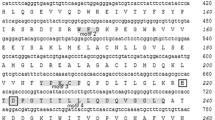Abstract
Using a cDNA encoding the flavanone 3β-hydroxylase (FHT) from Dianthus caryophyllus (carnation) as a probe, we isolated the FHT gene from a genomic library. Sequence analysis revealed that the FHT gene consists of three exons and two introns. Two putative light-regulated elements were identified in the promoter region by sequence comparison. Southern blot analysis indicated that a single copy of the FHT gene is in the plant genome. Furthermore, a stable and an unstable FHT mutant of D. caryophyllus, both showing almost no FHT activity, were analyzed by Southern, Northern and Western blotting. It turned out that the FHT gene is present in both mutants, but no protein was detectable in the mutant flowers. FHT mRNA in amounts comparable to that found in the wildtype is present in flowers of the stable mutant, indicating a block in translation, but not in flowers of the unstable mutant, indicating a block in transcription. The translational block of the FHT mRNA of the stable mutant was demonstrated by in vitro translation of total flower mRNA followed by the specific measurement of FHT activity.
Similar content being viewed by others
References
Beld M, Martin C, Huits H, Stuitje AR, Gerats AGM (1989) Flavonoid synthesis in Petunia hybrida: partial characterization of dihydroflavonol 4-reductase genes. Plant Mol Biol 13:491–502
Britsch L, Grisebach H (1986) Purification and characterization of (2S)-flavanone 3-hydroxylase from Petunia hybrida. Eur J Biohem 156:569–577
Britsch L, Ruhnau-Brich B, Forkmann G (1992) Molecular cloning, sequence analysis, and in vitro expression of flavanone 3β-hydroxylase from Petunia hybrida. J Biol Chem 267:5380–5387
Britsch L, Dedio J, Saedler H, Forkmann G (1993) Molecular characterization of flavanone 3β-hydroxylases, consensus sequence, comparison with related enzymes and the role of conserved histidines. Eur J Biochem 217:745–754
Feinberg AP, Vogelstein B (1983) A technique for radiolabeling DNA restriction endonuclease fragments to high specific activity. Anal Biochem 132:6–13
Forkmann G (1991) Flavonoids as flower pigments: The formation of the natural spectrum and its extension by genetic engineering. Plant Breed 106:1–26
Frischauf AM, Lehrach H, Poustka A, Murray N (1983) Lambda relacement vectors carrying polylinker sequences. J Mol Biol 170:827–842
Green PJ, Yong M-H, Cuozzo M, Kano-Murakami Y, Silverstein P, Chua N-H (1988) Binding site requirements for pea nuclear protein factor GT-1 correlate with sequences required for light-dependent transcriptional activation of the rbcS-3A gene. EMBO J 7:4035–4044
Henikoff S (1984) Unidirectional digestion with exonuclease III creates targeted breakpoints for DNA sequencing. Gene 28:351–359
Holdsworth MJ, Schuch W, Grierson D (1987) Nucleotide sequence of an ethylene-related gene from tomato. Nucleic Acids Res 15:10600
Joshi CP (1987a) An inspection of the domain between putative TATA box and translation start site in 79 plant genes. Nucleic Acids Res 15:6643–6653
Joshi CP (1987b) Putative polyadenylation signals in nuclear genes of higher plants: a compilation and analysis. Nucleic Acids Res 15:9627–9640
Koch I (1992) Enzyme der Flavonoidbiosynthese höherer Pflanzen: Enzymologische und immunologische Charakterisierungen der Chalkonsynthase, Flavanon 3-Hydroxylase und Dihydroflavonol 4-Reduktase. PhD thesis0, University of Tübingen, Germany
Köck M, Hamilton A, Grierson D (1991) Eth1, a gene involved in ethylene synthesis in tomato. Plant Mol Biol 17:141–142
Koes RE, Spelt CE, Mol JNM, Gerats AGM (1987) The chalcone synthase multigene family of Petunia hybrida: Sequence homology, chromosomal localisation and evolutionary aspects. Plant Mol Biol 10:159–169
Laemmli UK (1970) Cleavage of structural proteins during the assembly of bacteriophage T4. Nature 227:680–685
Logemann J, Schell J, Willmitzer L (1987) Improved method for the isolation of RNA from plant tissue. Anal Biochem 163:16–20
Matsuda J, Okabe S, Hashimoto T, Yamada Y (1991) Molecular cloning of hyoscyamine 6β-hydroxylase, a 2-oxoglutarate-dependent dioxygenase, from cultured roots of Hyoscyamus niger. J Biol Chem 266:9460–9464
Menssen A, Höhmann S,Martin W, Schnable PS, Peterson PA, Saedler H, Gierl A (1990) The En/Spm transposable element of Zea mays contains splice sites at the termini generating a novel inron from a dSpm element in the A2 gene. EMBO J 9:3051–3057
Sambrook J, Fritsch EF, Maniatis T (1989) Molecular cloning: a laboratory manual. Cold Spring Harbor Laboratory Press, Cold Spring Harbor, N. Y.
Sanger F, Nicklen S, Coulson AR (1977) DNA sequencing with chain-terminating inhibitors. Proc Natl Acad Sci USA 74:5463–5467
Schwarz-Sommer Z, Gierl A, Klösgen RB, Wienand U, Peterson PA, Saedler H (1984) The Spm (En) transposable element controls the excision of a 2 kb insert at the wx-m8 allele of Zea mays. EMBO J 3:1021–1028
Staiger D, Kaulen H, Schell J (1989) A CACGTG motif of Antirrhinum majus chalcone synthase promoter is recognized by an evolutionarily conserved nuclear protein. Proc Natl Acad Sci USA 86:6930–6934
Stich K, Eidenberger T, Wurst F, Forkmann G (1992) Flavonol synthase activity and the regulation of flavonol and anthocyanin biosynthesis during flower development in Dianthus caryophyllus L. (carnation). Z Naturforsch 47c:553–560
Van Tunen AJ, Koes RE, Spelt CE, Van der Krol AR, Stuitje AR, Mol JNM (1988) Cloning of the two chalcone flavanone isomease genes from Petunia hybrida: coordinate, light regulated and differential expression of flavonoid genes. EMBO J 7:1257–1263
Yanisch-Perron C, Vieira J, Messing J (1985) Improved M13 phage cloning vectors and host strains: Nucleotide sequences of the M13mp18 and pUC19 vectors. Gene 33:103–119
Author information
Authors and Affiliations
Additional information
Communicated by G. Wenzel
Rights and permissions
About this article
Cite this article
Dedio, J., Saedler, H. & Forkmann, G. Molecular cloning of the flavanone 3β-hydroxylase gene (FHT) from carnation (Dianthus caryophyllus) and analysis of stable and unstable FHT mutants. Theoret. Appl. Genetics 90, 611–617 (1995). https://doi.org/10.1007/BF00222123
Received:
Accepted:
Issue Date:
DOI: https://doi.org/10.1007/BF00222123




